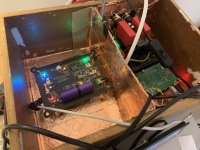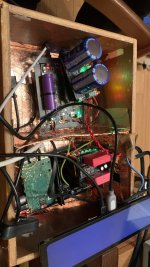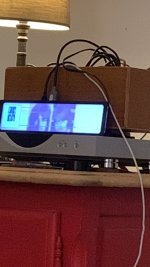I will also power my PurePi with a linear P/S and if somebody has already sorted this I want to know too 🙂Greetings from a fellow ASM member,
It looks like you may be powering PurePi with the linear supply. where do you input 5v to the PurePi?
The only input I see is USB-C.
Thanks, I’ve not been able to get this question answered.
Mike
I don't want to use the USB-C plug either.
@Oystein @pixelpusher
From my understanding the USB is the only input to the PurePi II.
The PurePi consist of two PSU; an ultra capacitor and a battery supply.
The 3.3v battery supply is meant to power sensitive gear such as a DAC, FiFoPi clean side and similar.
When the battery supply is switched on it is fully isolated by a relay from the grid, meaning you could use any power supply what so ever. It also has a SYNC function meaning it can charge the battery when the music is stopped (much receive SYNC signal from Q7 or similar).
The 5v super capacitor supply is also a good supply because it has the “help” from the super capacitors to improve any supply added at the USB-C input.
You can have a look at manual of the UcConditioner or UcMateConditioner for a further explanation with measurements.
iFi produce some well renowned 5v supply.
If it must be a linear PSU, audiophonics in France have this 5v 2A supply: https://www.audiophonics.fr/en/hifi...er-supply-usb-220v-to-5v-2a-25va-p-11364.html
It can make a continuous supply of 2A and peak with 3,5A up to 5 min.
Ian recommend a 2.5A supply, but the above one might just be sufficient.
You could ask Ian to double check.
I would consider the USB-C input on PurePi to just be a “power connector” in a USB-C package. No need for an intelligent PSU.
Again ask Ian to double check.
Regards Mikkel
From my understanding the USB is the only input to the PurePi II.
The PurePi consist of two PSU; an ultra capacitor and a battery supply.
The 3.3v battery supply is meant to power sensitive gear such as a DAC, FiFoPi clean side and similar.
When the battery supply is switched on it is fully isolated by a relay from the grid, meaning you could use any power supply what so ever. It also has a SYNC function meaning it can charge the battery when the music is stopped (much receive SYNC signal from Q7 or similar).
The 5v super capacitor supply is also a good supply because it has the “help” from the super capacitors to improve any supply added at the USB-C input.
You can have a look at manual of the UcConditioner or UcMateConditioner for a further explanation with measurements.
iFi produce some well renowned 5v supply.
If it must be a linear PSU, audiophonics in France have this 5v 2A supply: https://www.audiophonics.fr/en/hifi...er-supply-usb-220v-to-5v-2a-25va-p-11364.html
It can make a continuous supply of 2A and peak with 3,5A up to 5 min.
Ian recommend a 2.5A supply, but the above one might just be sufficient.
You could ask Ian to double check.
I would consider the USB-C input on PurePi to just be a “power connector” in a USB-C package. No need for an intelligent PSU.
Again ask Ian to double check.
Regards Mikkel
Last edited:
Thanks for your explanation.
My biggest “problem” is that I want to install the RPi against the rear panel of the box with a cutout for the LAN port and USB ports of the RPi.
The linear power supply will be in the same box so then I will need to get the 5V cable/connector outside the box to be able to feed it via USB-C.
I will measure the PurePi circuit to see where I can solder 2 wires on the board near the USB-C so I can feed it from inside 😊
My biggest “problem” is that I want to install the RPi against the rear panel of the box with a cutout for the LAN port and USB ports of the RPi.
The linear power supply will be in the same box so then I will need to get the 5V cable/connector outside the box to be able to feed it via USB-C.
I will measure the PurePi circuit to see where I can solder 2 wires on the board near the USB-C so I can feed it from inside 😊
Okay I see the problem. 🙂Thanks for your explanation.
My biggest “problem” is that I want to install the RPi against the rear panel of the box with a cutout for the LAN port and USB ports of the RPi.
The linear power supply will be in the same box so then I will need to get the 5V cable/connector outside the box to be able to feed it via USB-C.
I will measure the PurePi circuit to see where I can solder 2 wires on the board near the USB-C so I can feed it from inside 😊
It is not pretty sticking out at the back, but what about a 180 degree USB-C adapter or cable? Just found this as a referencehttps://a.aliexpress.com/_EIyiLuv Something a bit more neat and tidy must be out there…
Soldering as you suggested your self would be the best option🙂 Is the any room for soldering at the back of USB-C connector?
Another solution would be to extend the usb and lan port of the raspberry pi to the back panel with the raspberry further back in the chassis.
Last edited:
However there is something wrong, he shouldn't do it. The soft is a help but even so if you change the sound recording the "relè sound" comes out anyway...😕@Gappone
Thank you for sharing. I will find time to familiarize myself with the operation of GentooPlayer. Currently I still use RoPieee with Daphile. Today I tried to unplug the 2-pin PH2.0 SYNC control signal line from the MonitorPi. The deck became quiet immediately. But in this way, one of its original advantages was lost. I feel regretful.
Hi @Oystein - the special ferrite core that you will be using - could you please tell me where you are sourcing this from? Or is it a "custom-build"?For this Ian Canada set I will build a similar enclosure with a divider to protect the FifoPi Q7 + TransportPiAES as much as possible from EMI/RFI.
I will use a GPIO flat cable to connect the Q7 to the RPi4 but when passing the divider it will go through a special ferrite core:
I am also connecting my RPi3 to my FifoPi Q7 via GPIO ribbon cable and I'd be very interested in such a ferrite core.
Many Thanks !
Huge thanks @camrector for your insights. Really appreciate you taking the time to respond.As far as the R26 goes. IMHO the R26 is a better dac to casually listen too. It does all the right things and presents the music beautifully. Warm and airy. The R26 puts me in the candle lit jazz club with the best seats.
The ESS is just different. Technically superior, more accurate, laser precise, neutral and uncolored. It places me right next to the engineer in the Mastering Suite.
Decisions, decisions...... 🙂
I have just ordered IanCanada parts (FifoPi Q7II, HdmiPi Pro II, StationPi SMT, MonitorPi Pro) to build a streamer. I'll be using two UcPureMkIII supplies for +3.3V and +5V, and a LinearPi Mk II with UcConditioner MkII/Pro to power the RPi.
I am deciding between using MeanWell AC/DC modules to provide DC to the supplies, or ordering a custom Toroidy transformer to provide AC. What is the recommendation for best performance?
Thanks.
I am deciding between using MeanWell AC/DC modules to provide DC to the supplies, or ordering a custom Toroidy transformer to provide AC. What is the recommendation for best performance?
Thanks.
Hi @Oystein - the special ferrite core that you will be using - could you please tell me where you are sourcing this from? Or is it a "custom-build"?
I am also connecting my RPi3 to my FifoPi Q7 via GPIO ribbon cable and I'd be very interested in such a ferrite core.
Many Thanks !
The ferrite core is from Würth and available through Mouser, I need to order the 450F supercaps for the UCconditioner there anyway so can add it to the same order.
Link --> Würth ferrite core
I also made a schematic of how I will connect everything.
I will probably put the UCconditioner in the screened area with the Q7 and AES. I will also add a round ferrite on the 3.3V line when passing the grey barrier.

Very nice 🙂I use an AC transformer (3x9V), dipped in resin and shielded with a metal can. The transformer powers my 2xLinearPi and 1xSalas, which in turn power 3 UCconditioners, one UCconditioner (5V) powering the StationPiPro dirty side, one UCconditioner (5V) powering the StationPiPro clean side and one UCconditioner (3.3V) powering the FifoPi Q7 clean side.
I didn’t know about Giatras, I have ordered my trafos from Toroidy.
What is the price of the one you are using, if you don’t mind?
Thanks!
Lucian
@Oystein
I am definitively not an expert in HF and EMI but do have a question for clarification. The core you are using has like 100 Ohm round 100MHz. The inputs from the FiFoPi are high impedance as far as I know (Ian correct me when I am wrong) so let's say even when it is 10kohm, damping would be only like 100/10100 = 0,1 dB @100Mhz
When using this with power over the flat cable with low impedance at the board Vb input at high frequencies it will be a totally different story of course, but I see you do not power over the flat cable.
Anything wrong with my view, please correct me.
On the other hand, it is not always about calculations and technical details. Sound matters. did you do some A-B comparison sound wise? Did it make any significant difference?
thanks for elaborating. 🙂
I am definitively not an expert in HF and EMI but do have a question for clarification. The core you are using has like 100 Ohm round 100MHz. The inputs from the FiFoPi are high impedance as far as I know (Ian correct me when I am wrong) so let's say even when it is 10kohm, damping would be only like 100/10100 = 0,1 dB @100Mhz
When using this with power over the flat cable with low impedance at the board Vb input at high frequencies it will be a totally different story of course, but I see you do not power over the flat cable.
Anything wrong with my view, please correct me.
On the other hand, it is not always about calculations and technical details. Sound matters. did you do some A-B comparison sound wise? Did it make any significant difference?
thanks for elaborating. 🙂
If I remember correctly, it must have cost 55€.Very nice 🙂
I didn’t know about Giatras, I have ordered my trafos from Toroidy.
What is the price of the one you are using, if you don’t mind?
Thanks!
Lucian
Regards,
Panos
@dddac
I have not purchased any parts yet so I can not compare with / without ferrite.
You are correct in a high impedance network like I2S signals the effect will be small but don't forget the ribbon cable also carries the 3,3 + 5 Volt power (= low impedance) to the dirty side of the Q7.
With a noise source like the RPi the less noise you carry over to the Q7 (even if it is the dirty side) the better it will be.
I will test for sure once I can compare including measurement with an oscilloscope on both sides.
I have not purchased any parts yet so I can not compare with / without ferrite.
You are correct in a high impedance network like I2S signals the effect will be small but don't forget the ribbon cable also carries the 3,3 + 5 Volt power (= low impedance) to the dirty side of the Q7.
With a noise source like the RPi the less noise you carry over to the Q7 (even if it is the dirty side) the better it will be.
I will test for sure once I can compare including measurement with an oscilloscope on both sides.
Last edited:
Oh that’s definitely a good price and cheaper than toroidy supreme audio grade. I’m not convinced the toroidy is worth the price difference - they ask 100€ for a 2 sec. Yours has 3 sec.If I remember correctly, it must have cost 55€.
Regards,
Panos
@Oystein
aha! I did not see that clearly on your scheme (bit blind sometimes) When there is power over the ribbon and the impedance at the board at that frequency is low (Like a Polymer C eventually parallel with a 1uF MKP) at the input (can be placed extra) then there will be a clear reduction of power supply noise coming from the PI.... expect like 60dB at 10MHz os so...
Sure, I am looking forward to your feedback when you are ready...
aha! I did not see that clearly on your scheme (bit blind sometimes) When there is power over the ribbon and the impedance at the board at that frequency is low (Like a Polymer C eventually parallel with a 1uF MKP) at the input (can be placed extra) then there will be a clear reduction of power supply noise coming from the PI.... expect like 60dB at 10MHz os so...
Sure, I am looking forward to your feedback when you are ready...
Yesterday while testing I also had a USB power meter to see the actual load.
As I never see more than 1 A load even at startup of the RPi I guess the PurePi does a good job taking care of the load peaks due to the capacitors and LifePO4 batteries.
Do others see similar "low" loads ?


As I never see more than 1 A load even at startup of the RPi I guess the PurePi does a good job taking care of the load peaks due to the capacitors and LifePO4 batteries.
Do others see similar "low" loads ?


I noticed that as well. But where to buy Giatras?Oh that’s definitely a good price and cheaper than toroidy supreme audio grade. I’m not convinced the toroidy is worth the price difference - they ask 100€ for a 2 sec. Yours has 3 sec.
Their site isn't exactly informative of that.
- Home
- Source & Line
- Digital Line Level
- Asynchronous I2S FIFO project, an ultimate weapon to fight the jitter


